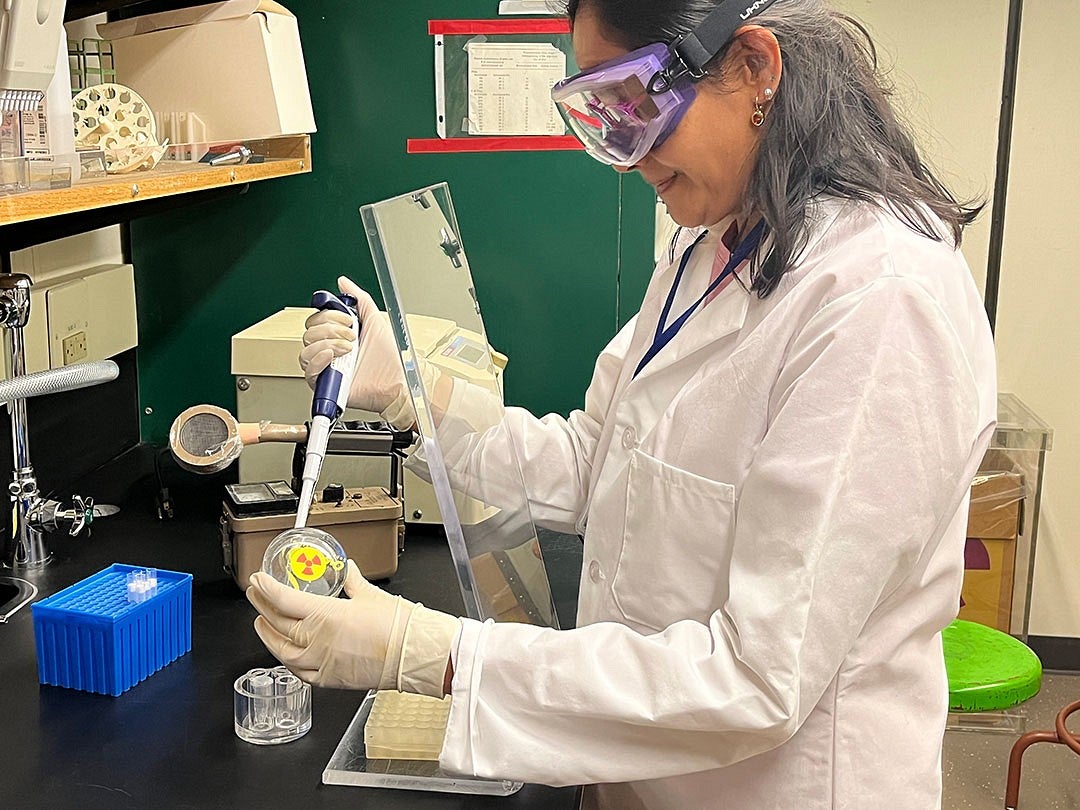The use of radiation sources for research and education is allowed through the practice of established procedures and demonstration of compliance. The Radiation Safety Program provides basic guidelines and procedures for safety to protect workers, facilities, the general public, and the environment. The program is tasked with monitoring the procedures and processes necessary to demonstrate compliance with the university’s license for use of radioactive materials and radiation-producing machines.
The program applies to all persons, regardless of their relationship to the university, working at or frequenting locations under university control where radioactive material or radiation-producing machines are used or stored.

Key Responsibilities
- Get Radiation Safety Committee Use Authorization.
- Ensure procedures required by Radiation Safety Committee and Radiation Safety Manual are followed.
- Read Radiation Safety Manual.
- Complete required Radiation Safety training.
- Follow SOPs and wear proper PPE.
- Report incidents within 24 hours.
Required Training
Before starting radioisotope work and every three years with use-authorization renewal, all authorized users must:
- Complete Radiation Safety: Fundamentals (initial training) and Radiation Safety: Refresher for User of Radioactive Materials (3 year refresher training).
- Complete lab-specific in-person training.
- Document all training.
- Review SOPs.
Additional hands-on training is available by contacting the EHS Radiation Safety Officer.
For online trainings, anyone unable to access MyTrack should email Lab and Research Safety for Community Canvas access or other alternatives.
Emergency Procedures
In case of incident:
- Prevent or reduce personnel contamination or injury.
- Get medical help immediately for eye or broken-skin exposure.
- Confine the containment.
- Prevent or reduce damage to equipment.
- Decontaminate the area.
- Report the incident to your PI or supervisor immediately and submit an injury report within 24 hours.
Notify EHS Radiation Officer immediately of any accident involving:
- Significant skin contamination.
- Ingestion of radioactivity by personnel.
- Unexpected personnel exposure.
- Severe contamination of equipment.
- Spread of contamination or difficulty in cleaning up a contaminated area.
- Loss of radioactive materials or radiation-producing machines.
Additional lab emergency procedures, safety equipment, and planning information are available in the Lab Safety Manual.
Waste Disposal Guide
Radioactive waste is collected by EHS. Use the Procedure for Radioactive Waste worksheet to determine the activity for each waste container (solids and liquids). For the worksheet and training on its use, contact the Radiation Safety Officer {ADD Email}.
Worksheets are returned to EHS Radiation Safety with their associated waste containers.
- Complete a Radioactive Waste Tag for each container. Each tag has a pre-printed unique red tag number.
- Schedule a hazardous waste pick up through the EHS Assistant. Instructions are available on the EHS Assistant webpage. Remember to include the Radiation Tag # in the content description, and isotope(s) and isotope activity in the container contents field.
Additional information may be found in the Radiation Safety Manual, Section IX, Radioactive Waste Disposal.
Radioactive Waste Tag
A radioactive waste tag must be completed and attached to each container of waste offered for collection. Complete only the front of the waste tag.
Waste tags are sequentially numbered, and tag number must be entered on the Radioactive Materials Receipt and Use Record and the Radioactive Waste Worksheet when accounting for waste disposal.
To complete the Radioactive Waste Tag:
Isotope - Enter the radioactive nuclide present in the waste container. Liquid waste is segregated according to nuclide. Dry waste is segregated as half-life > 90 days and half-life < 90 days. Liquid scintillation vial radioisotope combinations should be verified with EHS.
Activity - Enter the activity calculated on the Radioactive Waste Worksheet. Enter in millicuries of each nuclide.
Chemical Composition - List the chemicals by name (not formula) starting with the component of highest percent by volume. This includes water or other solvents. List all chemical components greater than 1% by volume. The complete chemical composition listing all components must be on file in the lab's Radiation Safety Program notebook.
- If a chemical hazard is present, also completes a hazardous waste label.
- If the waste has a final pH<5 or pH>10, note the component affecting pH.
- Dry waste may be described as: dry, solid, lab trash, or paper, plastic, glass. No liquids or scintillation vials are to be placed in the dry waste.
- List the brand name of the liquid scintillation cocktail used.
- Indicate the percent by volume of each chemical component.
Volume - The provided liquid waste bottles are 4L when filled 90% or to the shoulder of the container. The solid waste containers are 2 cubic feet.
Type - Check the type of waste the tag applies to.
Generator - Complete the information describing the Principal Investigator, person completing the waste tag, and contact phone number, building location, and date.
Purchasing Process
Radioactive material may only be procured by an Authorized user as determined by the Radiation Safety Committee. Procure includes: purchase, receipt by transfer from another lab, receipt from outside the university as a gift or demonstration sample, or any other receipt of radioactive material regardless of whether any monetary transaction is involved.
EHS Radiation Safety must approve all request for radioactive material prior to a purchasing agent placing a purchase. Material vendors require a copy of the university radioactive materials license. A completed purchase order that includes the authorization number, isotope, supplier and catalog number, and activity for each container of radioactive material must be approved by EHS.
Research purchases of radioactive materials are through the Institute of Molecular Biology buyers.
All radioactive material shall be shipped to and received by:
Environmental Health and Safety
University of Oregon
1230 Franklin Blvd
Eugene OR 97403-5224
Radiation Safety Program Manual
The Radiation Safety Manual is your guide to responsibilities, requirements, procedures, and templates.
Read the Radiation Safety Manual
Questions?
Contact the Radiation Safety Officer.
